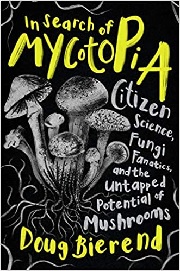In Search of Mycotopia: Citizen Science, Fungi Fanatics, and the Untapped Potential of Mushrooms

Doug Bierend
Chelsea Green Publishing, £18.00
In Search of Mycotopia is written in a descriptive, sometimes wry journalistic style, covering the author’s journeys around the globe in search of people and places dedicated to fungi.
Containing twelve chapters and a notes section full of references we are taken on a global exploration of the facts and philosophy relating to fungi and the human perspective of these organisms.
In chapter twelve Bierend takes us to Amazonia and myco-remediation. In this case he refers to long-term environmental damage caused by the oil industry being tackled by using native fungal species. He provides the reader with an ecological lesson that indigenous fungal organisms rather than introduced alien species need to do the job of bioremediation.
Building a ‘Myco-Scene’ (Chapter 7) also takes us on an exploration of how to not just ‘use’ fungi but to co-operate with them if we need a job to be done effectively and, to spread (like a mycelium) the word of the integral part fungi play in all life.
The most telling chapter describes the use of fungi to repair a national forest to its natural state after a catastrophic fire. The fire demonstrated the error of planting close-growing conifer monocultures for logging. After the fire, an inspirational restoration plan was devised based on the forest’s original ecology including the role of fungi to form an outdoor laboratory in the burned forest. This investigated wood-rotting fungi and their effects over time on the type of wood produced by the burned conifers. Indigenous fungi were effective at breaking down the wood, reinforcing the message that working with the local ecology is best and most effective instead of trying to change it.
In Search of Mycotopia stresses the importance of taking a holistic approach when it comes to the environment and human interactions with it.
Pat Sang MRSB


